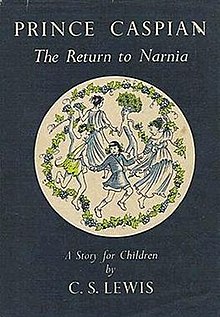
Back الأمير قزوين (رواية) Arabic Прынц Каспіян Byelorussian Прынц Касьпіян BE-X-OLD Принц Каспиан Bulgarian প্রিন্স ক্যাস্পিয়ান Bengali/Bangla Princ Kaspijan BS El príncep Caspian Catalan Princ Kaspian Czech Prince Caspian Welsh Prins Caspian (bog) Danish
 First edition dustjacket | |
| Author | C. S. Lewis |
|---|---|
| Illustrator | Pauline Baynes |
| Cover artist | Pauline Baynes |
| Language | English |
| Series | The Chronicles of Narnia |
| Genre | Children's fantasy novel, Christian literature |
| Publisher | Geoffrey Bles |
Publication date | 15 October 1951 |
| Publication place | United Kingdom |
| Media type | Print (hardcover) |
| Pages | 195 pp (first edition)[1] 44,740 words (US)[2] |
| ISBN | 978-0-00-671679-2 (Collins, 1998; full colour) |
| OCLC | 2812448 |
| LC Class | PZ8.L48 Pr[3] |
| Preceded by | The Lion, the Witch and the Wardrobe |
| Followed by | The Voyage of the Dawn Treader |
| Text | Prince Caspian online |
Prince Caspian (originally published as Prince Caspian: The Return to Narnia) is a high fantasy novel for children by C. S. Lewis, published by Geoffrey Bles in 1951. It was the second published of seven novels in The Chronicles of Narnia (1950–1956), and Lewis had finished writing it in 1949, before the first book was out.[4] It is volume four in recent editions of the series, sequenced according to the internal chronology of the books. Like the others, it was illustrated by Pauline Baynes and her work has been retained in many later editions.[1][3]
Prince Caspian features a "return to Narnia" by the four Pevensie children of the first novel, about a year later in England but 1300 years later in Narnia.[a] It is the only book of The Chronicles with men dominating Narnia. The talking animals and mythical beings are oppressed, and some may be endangered. The English siblings, legendary Kings and Queens of Narnia, are magically recalled, once again children, by the refugee Prince Caspian.
Macmillan US published an American edition within the calendar year.[1][3]
Prince Caspian has been adapted and filmed as two episodes of BBC television series in 1989 and as a feature film in 2008.
- ^ a b c "Bibliography: Prince Caspian". ISFDB. Retrieved 8 December 2012.
- ^ "Scholastic Catalog – Book Information". Archived from the original on 23 June 2014. Retrieved 23 June 2014.
- ^ a b c
"Prince Caspian, the return to Narnia" (first edition). Library of Congress Catalog Record.
"Prince Caspian, the return to Narnia" (first US edition). LCC record. Retrieved 2012-12-08. - ^ Roger Lancelyn Green & Walter Hooper, C. S. Lewis: A Biography, 2002, p. 309.
Cite error: There are <ref group=lower-alpha> tags or {{efn}} templates on this page, but the references will not show without a {{reflist|group=lower-alpha}} template or {{notelist}} template (see the help page).